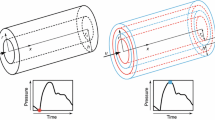Abstract
We derived and tested a new, simple, and accurate method to estimate the compliance of the entire arterial tree and parts thereof. The method requires the measurements of pressure and flow and is based on fitting the pulse pressure (systolic minus diastolic pressure) predicted by the two-element windkessel model to the measured pulse pressure. We show that the two-element windkessel model accurately describes the modulus of the input impedance at low harmonics (0–4th) of the heart rate so that the gross features of the arterial pressure wave, including pulse pressure, are accounted for. The method was tested using a distributed nonlinear model of the human systemic arterial tree. Pressure and flow were calculated in the ascending aorta, thoracic aorta, common carotid, and iliac artery. In a linear version of the systemic model the estimated compliance was within 1% of the compliance at the first three locations. In the iliac artery an error of 7% was found. In a nonlinear version, we compared the estimates of compliance with the average compliance over the cardiac cycle and the compliance at the mean working pressure. At the first three locations we found the estimated and “actual” compliance to be within 12% of each other. In the iliac artery the error was larger. We also investigated an increase and decrease in heart rate, a decrease in wall elasticity and exercise conditions. In all cases the estimated total arterial compliance was within 10% of mean compliance. Thus, the errors result mainly from the nonlinearity of the arterial system. Segmental compliance can be obtained by subtraction of compliance determined at two locations.
Similar content being viewed by others
Abbreviations
- a,b:
-
empirical constants
- C :
-
total volume compliance of systemic arterial tree
- C a :
-
area compliance
- C a,ref :
-
area compliance at reference pressure of 100 mm Hg
- F :
-
flow
- F m :
-
mean flow over the heart cycle
- P :
-
pressure
- P a,P b :
-
pressure constants
- P d :
-
diastolic pressure
- P m :
-
mean pressure over the heart cycle
- P s :
-
systolic pressure
- R :
-
peripheral resistance
- t :
-
time
- V :
-
systemic arterial blood volume
- Z in :
-
input impedance
- Ω:
-
basic angular frequency of the heart cycle
References
Elzinga, G.; Westerhof, N. Pressure and flow generated by the left ventricle against different impedances. Circ. Res. 32:178–186; 1973.
Frank, O. Die grundform des arterielen pulses erste abhandlung: mathematische analyse. Zeitschrift fuer Biologie 37:483–526; 1899.
Langewouters, G.J.; Wesseling, K.H.; Goedhard, W.J.A. The static elastic properties of 45 human thoracic and 20 abdominal aortas in vitro and the parameters of a new medel. J. Biomech. 17:425–435; 1984.
Laskey, W.K.; Parker, H.G.; Ferrari, V.A.; Kussmaul, W.G.; Noordergraaf, A. Estimation of total systemic arterial compliance in humans. J. Appl. Physiol. 69:112–119; 1990.
Latson, T.W.; Hunter, W.C.; Katoh, N.; Sagawa, K. Effect of nitroglycerin on aortic impedance, diameter, and pulse wave velocity. Circ. Res. 62:884–890; 1988.
Latson, T.W.; Yin, F.C.P.; Hunter, W.C. The effects of finite wave velocity and discrete reflections on ventricular loading. In: Yin, F.C.P., ed. Ventricular/vascular coupling. New York: Springer-Verlag; 1987; pp. 334–383.
Liu, Z.; Brin, K.P.; Yin, F.C.P. Estimation of total arterial compliance: an improved method and evaluation of current methods. Am. J. Physiol. 251:H588-H600; 1986.
O'Rourke, M.; Taylor, M.G. Input impedance of the systemic circulation. Circ. Res. 20:365–380; 1967.
Randall, O.S.; Esler, M.D.; Calfee, R.V.; Bulloch, G.F.; Maisel, A.S.; Culp, B. Arterial compliance in hypertension. N. Z. J. Med. 6:49–59; 1976.
Randall, O.S.; van den Bos, G.C.; Westerhof, N. Systemic compliance: Does it play a role in the genesis of essential hypertension?. Cardiov. Res. 18:455–462; 1984.
Stergiopulos, N.; Young, D.F.; Rogge, T.R. Computer simulation of arterial flow with applications to arterial and aortic stenosis. J. Biomech. 25:1477–1488; 1992.
Tardy, Y.; Meister, J.J.; Perret, F.; Brunner, H.R.; Arditi, M. Non-invasive estimate of the mechanical properties of peripheral arteries from ultrasonic and photoplethysmographic measurements. Clin. Phys. Physiol. Meas. 12:39–54; 1991.
Toorop, G.P.; Westerhof, N.; Elzinga, G. Beat-to-beat estimation of peripheral resistance and arterial compliance during pressure transients. Am. J. Physiol. 252:H1275-H1283; 1987.
Westerhof, N.; Elzinga, G.; Sipkema, P. An artificial arterial system for pumping hearts. J. Appl. Physiol. 31:776–781; 1971.
Yin, F.C.P.; Liu, Z.; Brin, K.P. Estimation of arterial compliance. In: Yin, F.C.P., ed. Ventricular/vascular coupling. New York: Springer-Verlag; 1987: pp. 384–398.
Yin, F.C.P.; Liu, Z. Estimating arterial resistance and compliance during transient conditions in humans. Am. J. Physiol. 257:H190-H197; 1989.
Yin, F.C.P.; Liu, Z. Arterial compliance—physiological viewpoint. In: Westerhof, N.; Gross, D.R., eds. Vascular dynamics. Physiological perspectives, New York: Plenum Press; 1989: pp. 9–22.
Author information
Authors and Affiliations
Rights and permissions
About this article
Cite this article
Stergiopulos, N., Meister, J.J. & Westerhof, N. Simple and accurate way for estimating total and segmental arterial compliance: The pulse pressure method. Ann Biomed Eng 22, 392–397 (1994). https://doi.org/10.1007/BF02368245
Received:
Revised:
Accepted:
Issue Date:
DOI: https://doi.org/10.1007/BF02368245



